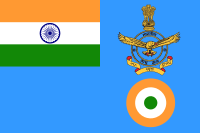Jack Higgins (RAF officer)
Air Marshal Sir John Frederick Andrews Higgins, KCB, KBE, DSO, AFC (1 September 1875 – 1 June 1948), known as Jack Higgins, was a senior officer in the Royal Flying Corps, serving as a brigade commander from 1915 to 1918. After the First World War he served in a range of senior posts in the Royal Air Force until his retirement in 1930. He returned to active service for the first year of the Second World War.
John Frederick Andrews Higgins | |
|---|---|
| Born | 1 September 1875 |
| Died | 1 June 1948 (aged 72) Leamington, England |
| Allegiance | United Kingdom |
| Service/ | British Army Royal Air Force |
| Years of service | 1895–1930 1939–1940 |
| Rank | Air Marshal |
| Commands held | Air Forces in India (1939–40) Air Member for Supply and Research (1926–30) Iraq Command (1924–26) Inland Area (1922–24) Northern Area (1919–20) RAF Rhine (1919) Midland Area (1918–19) No. 3 Area (1918) III Brigade RFC (1916–18) VI Brigade RFC (1916) II Brigade RFC (1915–16) RFC Training Wing (1914–15) No. 5 Squadron RFC (1913–14) |
| Battles/wars | Second Boer War First World War Second World War |
| Awards | Knight Commander of the Order of the Bath Knight Commander of the Order of the British Empire Distinguished Service Order Air Force Cross Mentioned in Despatches (6) Officer of the Legion of Honour (France) |
| Other work | Director of Air Service Training Ltd |
RAF career
Higgins became a cadet at the Royal Military Academy, Woolwich and was commissioned into the Royal Field Artillery as a second lieutenant on 15 June 1895, and promoted to lieutenant on 15 June 1898. He served in the Second Boer War in South Africa, where he took part in the operations in Natal in 1899, including actions at Rietfontein and Lombard's Kop. Severely wounded in early January 1900, during the Defence of Ladysmith, he was later back in action and was promoted to captain on 15 March 1901.[1] After the end of the war in June 1902, Higgins left Cape Town in the SS Bavarian in August, returning to Southampton the following month.[2] For his service during the war, he was mentioned in despatches and awarded the Distinguished Service Order (DSO) dated 29 November 1900.[3]
After his return, he was posted at Ammunition Park, Aldershot Garrison. He served as Officer Commanding No. 5 Squadron from July 1913 and then at the start of November 1914, Higgins was selected to head up the RFC's training wing which was based at Netheravon.[4] He went on to command II Brigade RFC, VI Brigade RFC and then III Brigade RFC during the course of the First World War.[5] In the closing stages of the war he was General Officer Commanding No. 3 Area and then General Officer Commanding Midland Area.[5]
After the War he was appointed General Officer Commanding RAF forces of the Rhine and then Air Officer Commanding Northern Area before becoming Director of Personnel at the Air Ministry in 1920.[5] He went on to be Air Officer Commanding Inland Area in 1922, Air Officer Commanding Iraq Command in 1924 and Air Member for Supply and Research in 1926.[5] He retired to India in 1930 but was recalled as Air Officer Commanding-in-Chief of the Air Forces in India in October 1939 at the start of the Second World War before retiring again in August 1940.[5]
References
- Hart′s Army list, 1903
- "The Army in South Africa - Troops returning home". The Times (36856). London. 26 August 1902. p. 4.
- "No. 27359". The London Gazette. 27 September 1901. p. 6308.
- Macmillan, Norman. Sir Sefton Brancker p. 81
- Air of Authority – A History of RAF Organisation – Air Marshal Sir John Higgins
| Military offices | ||
|---|---|---|
| New title Squadron formed |
Officer Commanding No. 5 Squadron 1913–1914 |
Succeeded by Archibald MacLean |
| New title Wing formed from elements of the Military Wing |
Officer Commanding No. 4 (Training) Wing 9 November 1914 – 1915 |
Succeeded by Unknown |
| Preceded by Tom Webb-Bowen |
Officer Commanding No. 3 Wing 2 June – 25 August 1915 |
Succeeded by Sefton Brancker |
| New title Brigade formed |
Brigadier-General Commanding 2nd Brigade RFC 23 October 1915 – 15 January 1916 |
Vacant 2nd Brigade re-designated as the 6th Brigade Title next held by John SalmondIn February 1916 |
| New title Brigade formed by re-designating the 2nd Brigade |
Brigadier-General Commanding 6th Brigade RFC 15–30 January 1916 |
Succeeded by Unknown |
| New title Brigade formed |
Brigadier-General Commanding 3rd Brigade RFC RAF from 1 April 1918 30 January 1916 – 29 April 1918 |
Succeeded by Charles Longcroft |
| Preceded by Cecil Lambert |
RAF Director of Personnel 1920 |
Succeeded by Unknown |
| Preceded by John Salmond |
Air Officer Commanding Iraq Command 1924–1926 |
Succeeded by Edward Ellington |
| Preceded by Sir Geoffrey Salmond |
Air Member for Supply and Research 27 December 1926 – 1 September 1930 |
Succeeded by Hugh Dowding |
| Preceded by Sir Philip Joubert de la Ferté |
Commander-in-Chief, Air Forces in India 1939–1940 |
Succeeded by Sir Patrick Playfair |
